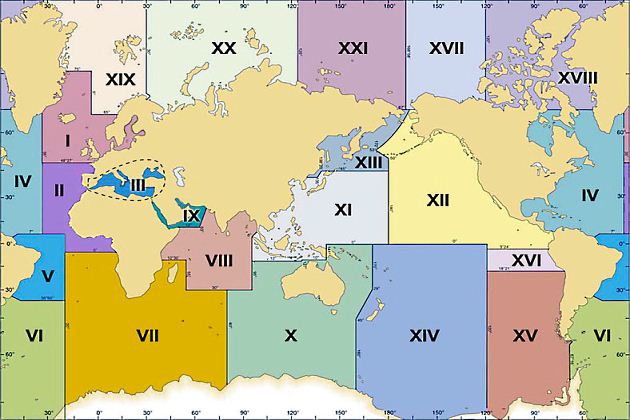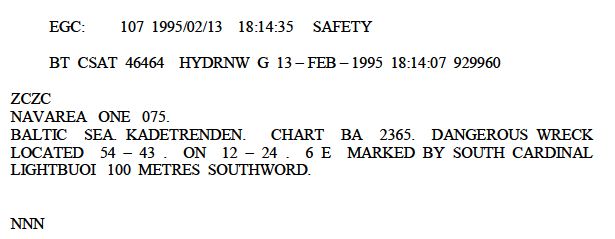Maritime Safety Information is defined in general terms as “navigational and meteorological warnings, meteorological forecast and other urgent safety-related messages” of vital importance to all ships at sea. It may also include electronic chart correction data.
The MSI service is an international coordinated network of broadcasting of Maritime Safety Information from official information Providers such as:
- National Hydrographic Offices, for navigational warnings and electronic chart correction data;
- National Meteorological Offices, for weather warnings and forecasts;
- Rescue Coordination Center (RCCs) for shore to ship distress alerts, and other urgent information;
- The International Ice Patrol, for North Atlantic ice hazards.
Reception of MSI broadcasts is free of charge to all ships MSI is transmitted by a variety of means, using terrestrial and satellite radiocommunication. The GMDSS supports two independent systems for broadcasting MSI.
NAVTEX
The international NAVTEX service is the system for the broadcast and automatic receipt of MSI by means of narrow band direct printing on 518 kHz, using the English language, to meet the requirements of the SOLAS Convention.
The information provider forwards the MSI for a given area to a 518 kHz MF NAVTEX transmiter. The purpose of the NAVTEX system ia essentially to provide MSI relevant to the coastal areas within the range of the MF NAVTEX transmiter network.
SafetyNET System
Complementary MSI services are provided by this international automatic direct printing satellite based service SafetyNET operated by Inmarsat. SafetyNET fulfils an integral role in the GMDSS as requirements for the ships to which the SOLAS Convention applies. The ability to receive SafetyNET Service Information will be necessary for all ships which sail beyound the coverage of NAVTEX.
The Information Provider forwards the SafetyNET MSI for a given area to an Inmarsat-C Coast Earth Station (CES) for broadcasting via the satellite network over an entire Inmarsat-C Ocean Region. Ships can therefore receive SafetyNET information anywhere in that ocean region, irrespective of their distance from the CES/Information Provider. This is an obvious advantage when sailing remote areas but it is vital to select the correct Ocean Region on the receiver otherwise, there is a danger that inappropriate information will be received.
Read also: Empowering Global Communication with INMARSAT Satellites in shipping
MSI for a given area is generally over either NAVTEX or SafetyNET (except for some circumstances where a message may be broadcast using both services); ships equipped with both NAVTEX Receiver and a SafetyNET Receiver should select an appropriate receiver to receive MSI for a particular area. Where a coastal area is not covered by the international NAVTEX service, for example around Australia, MSI for that area will be broadcast on SafetyNET.
NAVAREAs/METAREAs
The world is divided into “NAVAREAS” for the transmission of MSI. Figure below shows the 16 Navigational Areas (NAVAREAs). These are the same as the Meteorological Areas (METAREAs) into which the earth’s navigable waters are sub-divided for the purpose of SafetyNET broadcast. For each area, a NAVAREA Coordinator coordinates the broadcasting of navigational warnings, and a Meteorological Issuing Service coordinates the meteorological information throughout that area.

Source: en.wikipedia.org
Extensive co-operation between neighbouring countries is often necessary – NAVTEX MSI for NAVAREA-1 is, for example, supplied by twelve European stations.
There may be also permanent arrangements in place whereby an Administration requests a neighbouring country to transmit MSI on its behalf in order to improve reception.
To find out which MSI service, NAVTEX or SafetyNET, serves a particular area, a user should refer to the information for that particular area contained in the ITU List of Radiodetermination and Special Services Stations or relevant publications produced by national Administrations and service providers.
MSI Broadcast
To ensure that the user knows when to receive MSI for a given area and subject, many MSI broadcasts are scheduled, under IMO coordination to particular times, CES and Ocean Region.
All navigational warnings and meteorological forecasts are scheduled broadcasts with safety priority, which does not produce an alarm at the receiver.
NAVTEX Equipment
NAVTEX broadcasts are telex transmissions using FEC mode and are normally received by a dedicated receiver which contains a printer and/or display and microprocessor and provides the following functions:
- Receive only selected stations.
- Receive only certain types of messages.
- Prevent the reception of the same message again.
- Store received information.
- Prevent printing if signal is not good enough.
All NAVTEX messages are prefixed by a 4-character group; the first denotes the transmitting station, the second the message category, the third and fourth the serial number. The category code 00 denotes urgent traffic and it will always be printed.
Message Category
At the NAVTEX receiver the information printed or displayed may be selected to meet operational requirements by rejecting certain classes of message. However messages with distress or safety connotations cannot be suppressed.
The NAVTEX message categories are:
- A* – navigational warnings.
- B* – gale warnings.
- C – ice reports.
- D* – distress alerting plus SAR/Piracy information.
- E – weather forecast.
- F – pilot services information.
- G – Decca messages.
- H – Loran messages.
- I – Omega messages.
- K – other navigational messages.
- L* – rig movements.
- V – amplification of NAV WARNINGS in A.
- Z – no messages on hand.
*These messages cannot be rejected by the receiver.
NAVTEX Languages
The 518 kHz NAVTEX transmissions are in English. However, equipment and retrofit circuit modules are now available which will allow the reception of national languages MSI broadcasts on 490 kHz or, in the tropical regions, 4209,5 kHz.
SafetyNET
SafetyNET Broadcast
To be sure of receiving a scheduled MSI, the equipment must be tuned to the appropriate channel and satellite at the specified time by logging on to the appropriate Ocean Region.
Urgent navigational warnings, severe weather warnings, and GMDSS Distress and Safety Communicationsdistress alert relays are transmitted as unscheduled SafetyNET broadcasts over all satellites covering the area concerned, so that the receiver will not miss the message, irrespective of the ocean region being monitored.
The user is advised of the receipt of an unscheduled message by the terminal giving an alarm.
All MSI broadcast made in the international MSI service are printed in the English language national languages may be added after the English text.
To avoid excessive duplication of broadcasts, the IMO has authorised the following arrangements:
- For a given NAVAREA/METAREA which is covered by more than one Ocean Region satellite, scheduled broadcast of MSI such as gale warnings and meteorological information, is made only via a single nominated satellite/Ocean Region.
- For a NAVAREA/METAREA which is covered by more than one Ocean Region satellite, unscheduled broadcast of MSI, such as gale warnings and distress alerts are made via all satellites/Ocean Region which cover the area concerned.
EGC SERVICE
The Inmarsat-C satellites communication system has a capability known as Enhanced Group Call (EGC), which enables Information Providers to send messages for selective reception by EGC receivers located anywhere in the four Ocean Regions.
The Information Provider determines which receivers are to receive the message by including identifying information such as the NAVAREA/METAREA or a defined geographical area for which the MSI is intended along with the message. Individual EGC receivers can be programmed to use this information to select only the required messages, and to reject all others.
Based on this selective capability the EGC system supports two services:
- The EGC SafetyNET service, which allows the EGC receiver operator to program the receiver with the geographical areas for which MSI will be received, and the categories of MSI messages required.
- The EGC FleetNET service, which is a commercial service, where individual EGC receivers are programmed to store an EGC Identification (ENID) code, which is used to select only messages intended for ships belonging to a group, such as a fleet or national flag, or subscribers to an information service.
SafetyNET Messages
A registered Information Provider, such as a national Hydrographic Office, Rescue Coordination Centre (RCC), or Meteorological Office, receives information from its specialised sources.
Each Information Provider prepares an MSI message in a standardised format, and submits it to the appropriate coordinator (Navigational Warning Coordinator, SAR Coordinator, or Meteorological Issuing Service).
The coordinator checks the message with any other information received, and edits it accordingly, the submits then finalised text to a selected Inmarsat-C CES.
Included with the message are the following codes (known as the “C” code), to instruct the CES and SES on how to process the message automatically:
- Priority Code (distress, urgency, safety, or routine);
- Service Code, to identify the message type: for example, a shore-to-ship distress alert or a meteorological forecast;
- Address Code, to identify the geographical area to which the MSI is applicable – this may be a fixed geographical area such as one of the 16 NAVAREA/METAREAs shown or a temporary area determined by the originator, such as a rectangular area;
- Repetition Code, to indicate the number of times the message should be broadcast;
- Presentation Code, to indicate the character set in which the message will be transmitted and printed. (The character set that is used is always the international alphabet number 5, which is also known as 7-bit ASCII).
The Information Provider may also choose the scheduled time(s) at which the message is to be broadcast, and if a CES operates in more than one Ocean Region, the satellite to be used.
The CES receives the messages with its instructions, and queues them with any other messages received, according to priority and scheduled time of transmission.
At the required time for transmission, the CES forwards the messages over the Interstation Signalling Link (ISL) to the NCS for the Ocean Region.
The NCS automatically broadcasts the message on the NCS Common Signalling Channel over the entire Ocean Region.
All EGC receivers that meet SOLAS requirements will receive the MSI and then print the message, unless the operator has chosen to reject messages of that type, or the message is a recent repeat.
Selective Reception
Althought EGC receivers will receive and can print all SafetyNET broadcasts made throughout an entire Ocean Region, many messages may not be useful to the ship – for example, those applicable to NAVAREAss beyond the ship’s planned voyage,or those on subject not relevant to the ship’s circumstances. To avoid printing out a large number of unnecessary messages, the EGC receiver can be programmed to print only the essential messages, and to reject all other messages. To this end, every receiver is supplied with software which stores the Geographical boudaries of the BAVAREAs; the receiver then uses this information to print only those messages applicable to the current area, plus any other areas messages applicable to the current area, plus any other areas programmed by the operator.
N. B. The receiver cannot be programmed to reject “all ships” messages, such as some shore-to-ship distress alerts and Met/Nav warnings.
The receiver examines the message handling instructions (the “C” codes) included with each message, and uses this information to decide which messages to print.
It will be interesting: TELEX (Narrow Band Direct Printing – NBDP) Procedures
Similarly, the receiver stores the unique number included with each message, and uses this to avoid printing extra copies of those messages already received and printed correctly.
Position Updates
The EGC receiver must be updated regularly with the ship position in order to ensure that:
- the receiver can print all messages addressed to a specific geographically area;
- printing is restricted to just those messages for the selected areas, otherwise the receiver will automatically print or store all geographical addressed messages within the entire Ocean Region if the ship’s position is not updated for 12 or 14 hours.
Mandatory Message Reception
Under SOLAS requirements (as well as for the safety of all aboard), receipt of the following types of EGC messages is mandatory:
- Shore-to-ship distress alert relays for the current NAVAREA;
- Navigational warnings for the current NAVAREA;
- Meteorological warnings for the current METAREA.
Optimal Message reception
In addition to mandatory message types, the IMO recommends that the EGC receiver is also programmed to receive the following messages:
- Meteorological forecast.
- MSI for any other NAVAREAs in which the ship is expected to sail.
N. B. The NAVAREAs specified do not need to be adjacent to the current area.
Printing Essential Messages
To ensure that the EGC receiver prints only the essential messages required, and rejects all others, ensure that:
- the receiver is updated regularly with the ship’s position;
- the receiver is set to reject for any NAVAREAs outside the area of interest;
- the receiver is set to reject messages type not required;
- the receiver does not print multiple copies of repeated messages.
Reducing the Number of Alarms
The EGC receiver is programed to give an audible/visual alarm on printing any distress alerts or urgent messages since these require an immediate response. To eliminate any unnecessary alarms, ensure that:
- the ship position is updated regularly so that the receiver rejects messages for any geographical areas irrelevant to the ship’s position;
- the receiver is set to give an alarm only for distress and urgent messages.
Repeated MSI broadcast
Some classes of EGC receivers/SESs may not provide uninterrupted monitoring of the channel used for MSI broadcasts and may switch to a different channel for normal commercial traffic. To improve the chance of these receivers receiving MSI broadcast, Information Provider re-broadcast some messages as follows:
- Unscheduled messages, such as distress alerts and gale warnings, are re-broadcast 6 minutes after the initial broadcast;
- Scheduled broadcasts, such as navigational warnings, are repeated at every scheduled time for as long as they remain in force.
Missed messages
If any messages have been missed, for example at a scheduled broadcast time, try the following:
- Switch the terminal off and on again – this will clear the internal memory of all stored messages Ids, so that if the message is re-broadcast again the receiver will not reject as a repeated message and will print it.
- Check whether the CES which broadcast the message offers a rebroadcast facility.
Good Operating Practice
The following advice intended to achive the best possible use of the SafetyNET service:
- Ensure that all equipment associated with the EGC receiver is working properly, as indicated in the manufacture’s instructions, and that the printer is loaded with paper.
- Ensure that no unwanted messages are retained and that the terminal has sufficient storage space for new messages.
- Consider using a small font, if possible, to reduce the amount paper used for messages.
- Ensure that the ship’s position is updated regularly so that only appropriate MSI is received throughout the voyage.
- Enter all NAVAREAs/MATAREs and coastal areas appropriate to the voyage into the terminal.
- Enter the wanted MSI messages types and reject any unwanted types.
- While in port, keep the EGC receiver in operation, to ensure that all necessary MSI is available before sailing.
- To maintain continuous MSI reception from a particular satellite/Ocean Region, the automatic Inmarsat-C scan facility should be set to scan the desired Ocean Region, by making it the only preferred Ocean Region – for details, refer to the Inmarsat-C Maritime Communications Handbook.
- Ensure that a written log is kept of the identities of all received messages throughout the voyage, and that a printed copy is kept on board of the all distress traffic. Other messages should be kept on the bridge as long as they remain in force.
N. B. If the EGC receiver facility shares a directional antenna with an Inmarsat-A SES, ensure that the antenna tracks the appropriate satellite at the time of a scheduled broadcast. This configuration is not recommended.
Troubleshooting
If no MSI has been printed or stored within a 24 hours period, try the following:
- Check message availability, making sure that the terminal is monitoring the appropriate satellite/Ocean Region at the time of a scheduled broadcast.
- Carry out a Performance Verification Test (PVT) on the Inmarsat-C SES, referring to the manufacturer’s instructions for details.
- Use the 2-digit code service 33 (Request for technical assistance) with a selected CES that supports the service.
Example of Messages
Typical MSI broadcast:
In the examples note the following features:
- The date and time of the message in UTC.
- The identifier of the CES sending the message:
- BT CSAT – bitish telecom Inmarsat-C.
- A unique number identifying the message: 929960
- The priority of the message.
- The nature of the message.


